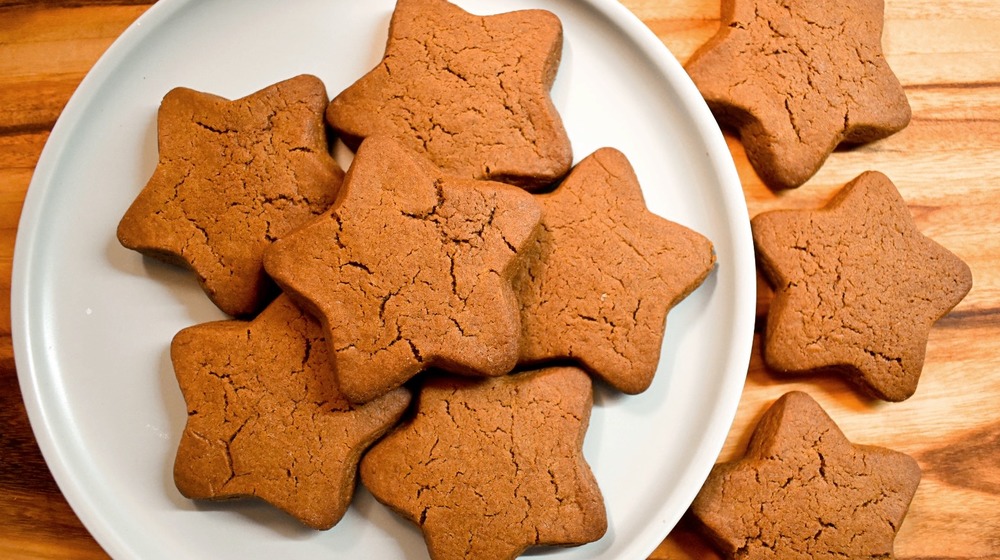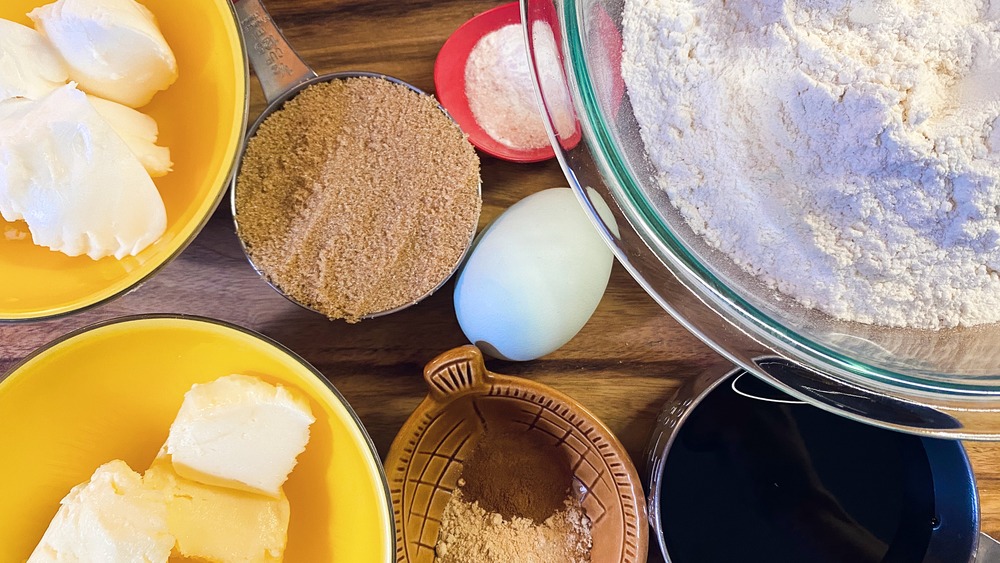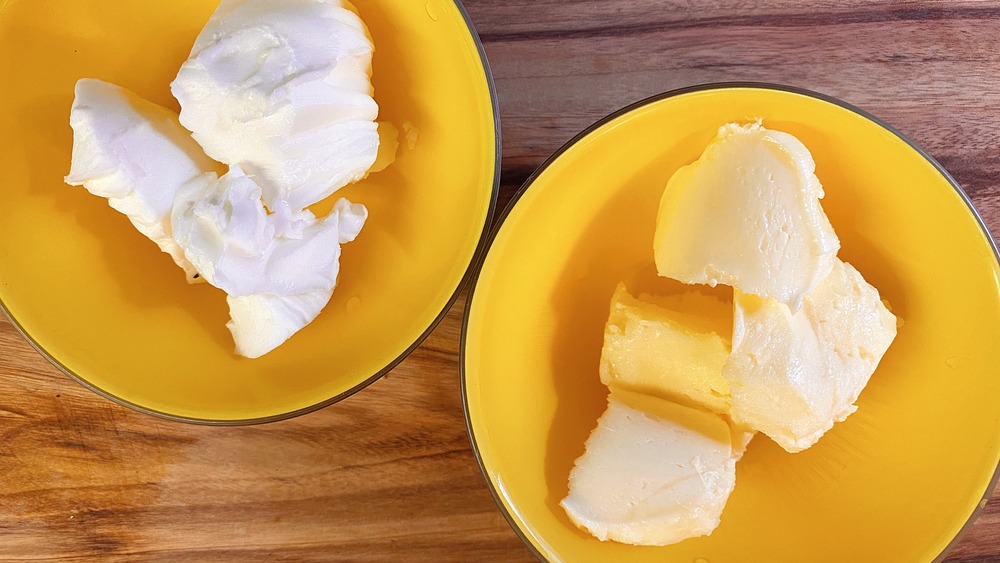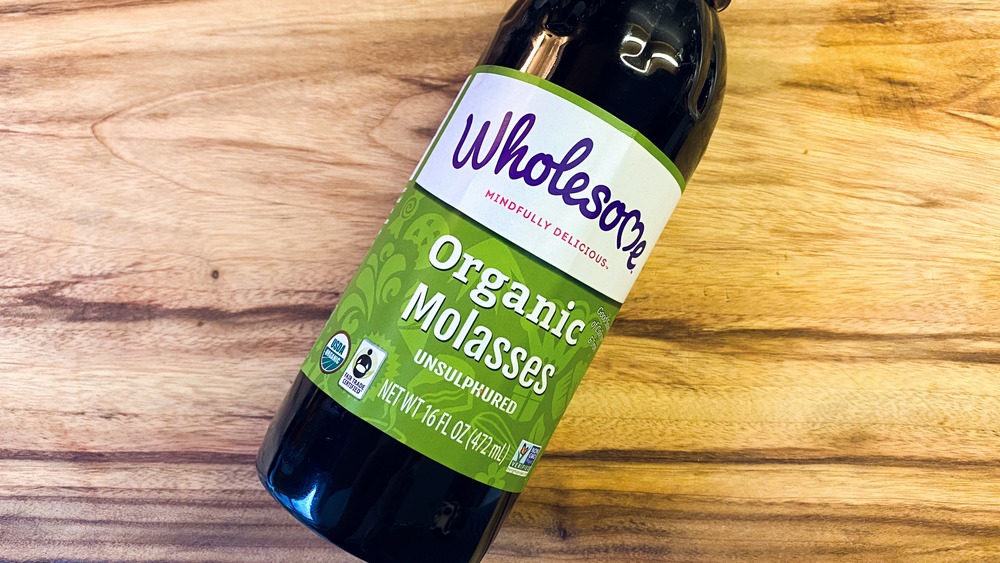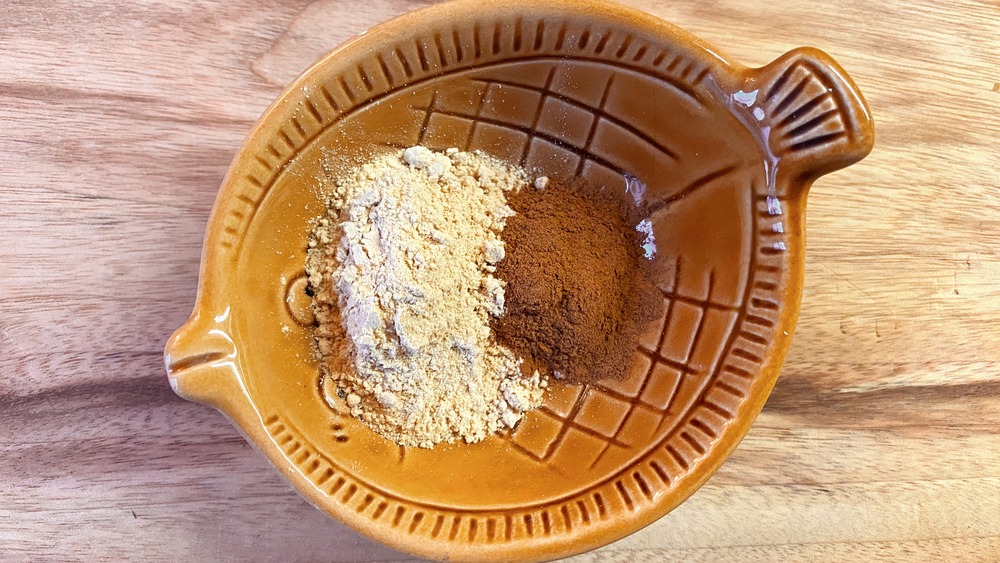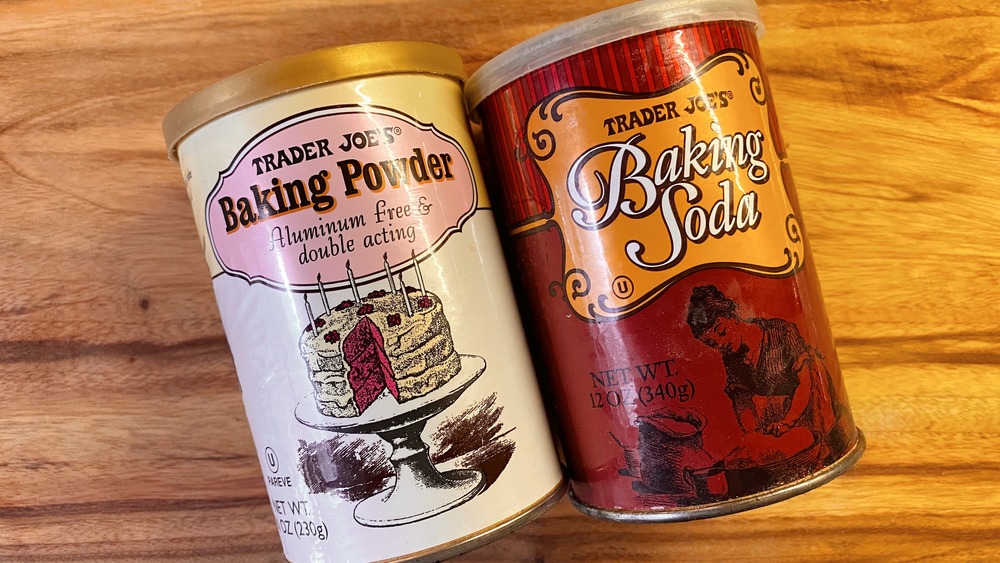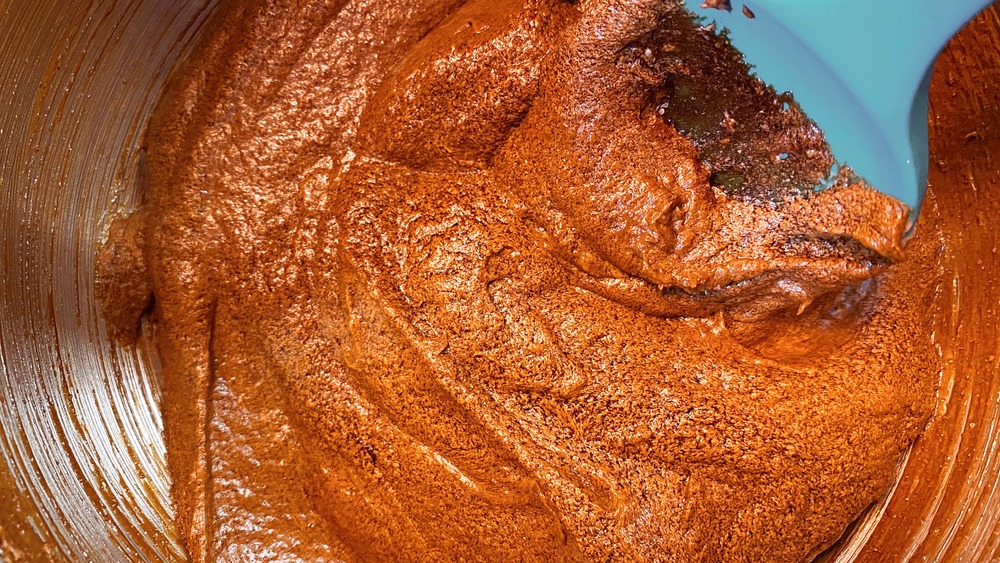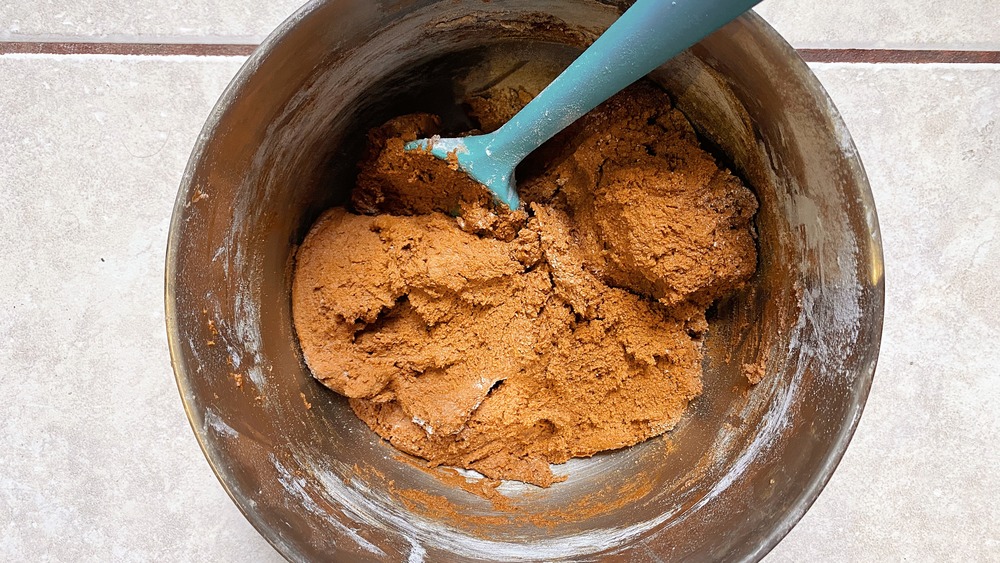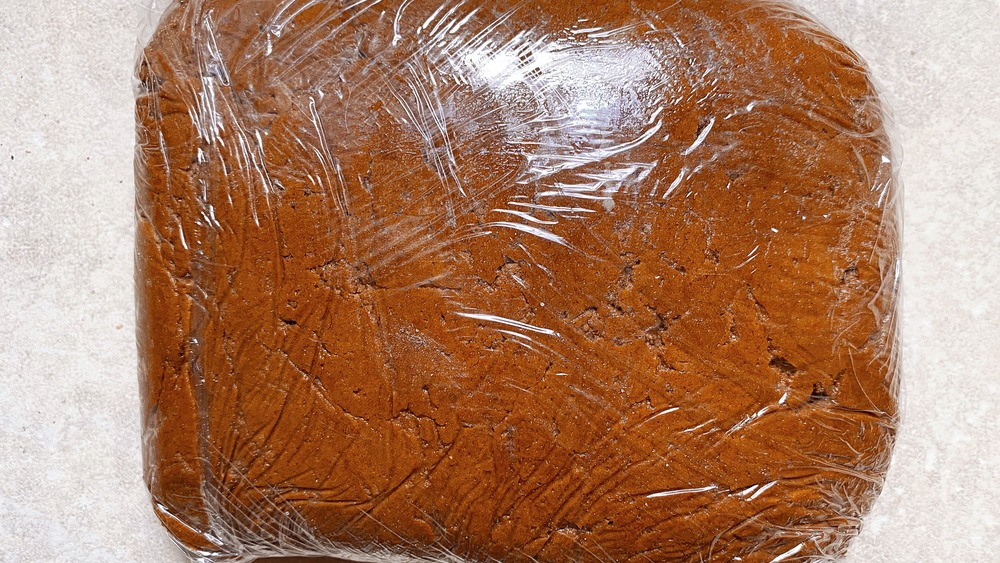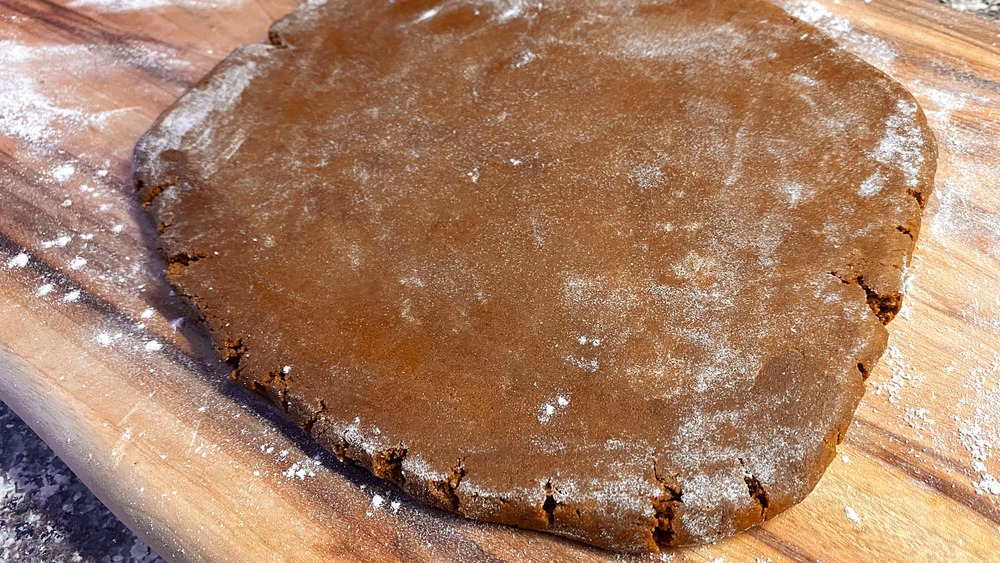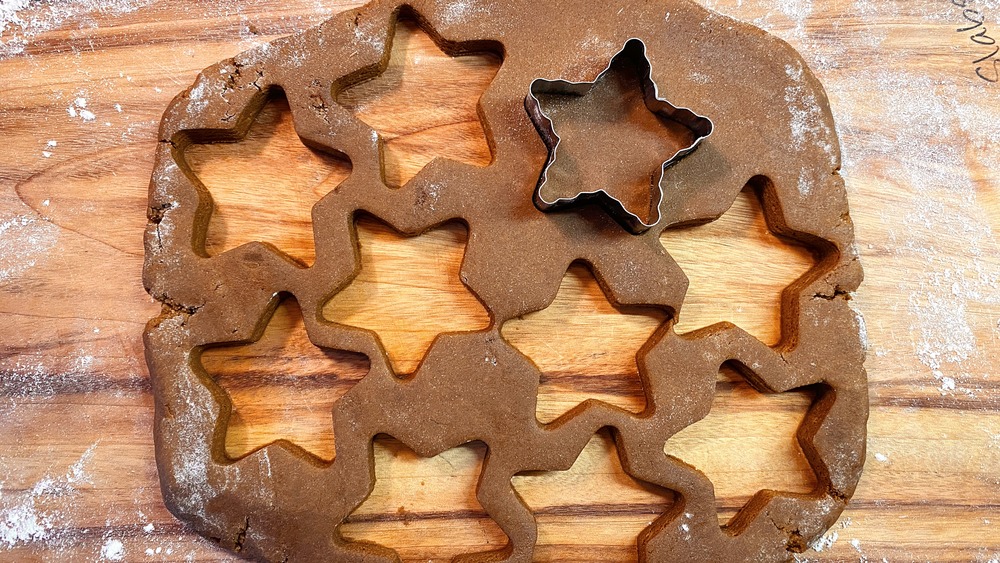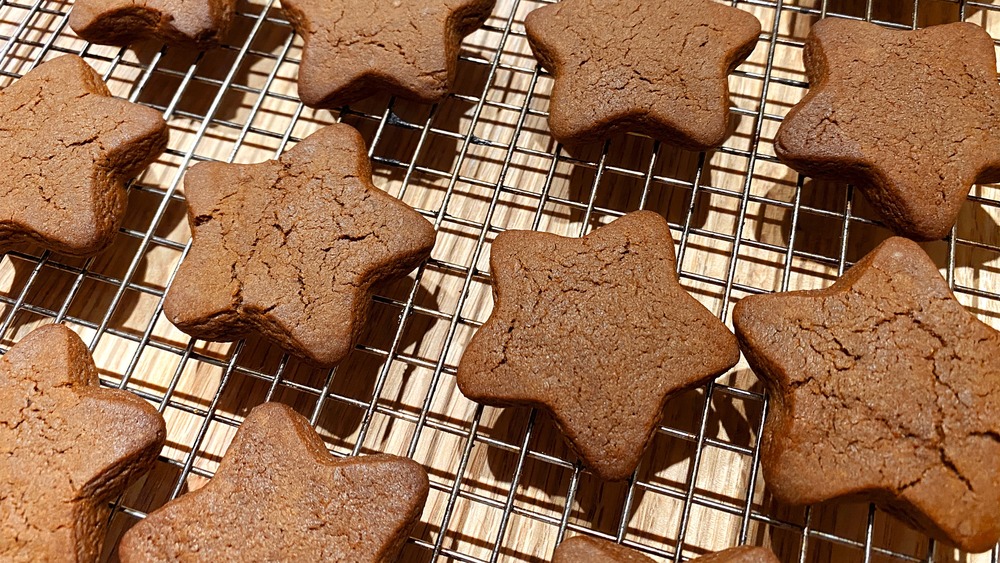Gingerbread Cookie Recipe
Few things evoke the holiday season like gingerbread cookies, but this classic treat doesn't often get the credit it really deserves. Most people think of gingerbread purely for aesthetic purposes — as a construction material for gingerbread houses, from the simplest four-sided outfits to palatial villas, or as a vehicle for gumdrops and frosting in the form of gingerbread people. Take all of that away and you get something that, as a holiday treat, is typically hard and unappealing.
These cookies will turn your preconceived notions about gingerbread upside down. While you can frost these cookies, they don't really need any embellishment or classic holiday cookie decorations. They're just sweet enough, have a delightful warming spice flavor, and a boast chewy texture that makes these some of the most delicious cookies of the holiday season. While they aren't particularly difficult to make, there are a few key ingredients and important steps when it comes to making gingerbread cookies that you'll actually want to eat. Read on to learn our secrets.
Gather the ingredients to make gingerbread cookies
While there is nothing really groundbreaking in these gingerbread cookies, there are two ingredients that you might not typically keep in your pantry that are ideal for making the best gingerbread cookies. The first one is molasses and the second one is vegetable shortening. While the shortening can be substituted (more on this later), you really can't make gingerbread cookies without molasses. Fortunately, most groceries stores sell it, especially during the holiday season. Apart from those slightly less common ingredients, you'll need butter, brown sugar, all-purpose flour, both baking powder and baking soda, cinnamon, ginger, and optional spices like nutmeg and cloves.
While we like to use a stand mixer to make these gingerbread cookies, a hand mixer will work just as well. If you don't have either, don't worry — you can still make them! However, you'll need to make sure that both your butter and your shortening are very soft in order to make these cookies without an electric mixer. This will require a little bit of advanced planning. The best way to make sure your butter is soft enough to cream by hand is to leave it out on the counter overnight.
Use half butter and half shortening for tender, flavorful gingerbread cookies
If you do keep vegetable shortening like Crisco in your house, it's probably because you use some older recipes around the holidays. According to n+1 magazine, shortening was popular in the earlier parts of the 20th century because it was shelf-stable, cheaper, and more readily available than butter. In many cases, shortening also produces a more tender final product than butter, which is why some bakers swear by it for things like pie crusts and cookies. However, shortening lacks the rich flavor of butter. Our solution? We like to use a mixture of half butter and half shortening, which will give you the best of both worlds. Using this ratio, we get soft, tender gingerbread cookies that have the depth of flavor only butter can provide. If you don't have shortening on hand or prefer not to use it, you can make all-butter gingerbread cookies instead. They will be very delicious, though a bit on the flatter, crispier side. Similarly, you can also use all shortening, though the results won't have as much flavor as a mix incorporating butter.
Molasses gives gingerbread cookies their signature color and flavor
Don't let yourself be fooled into thinking that brown sugar and spices are enough to give gingerbread its signature deep caramel color and telltale flavor. Molasses is one ingredient that you cannot substitute when making these gingerbread cookies! Because molasses is a liquid, it will help to give your cookies an even more tender texture after they're baked. It also has a completely unique flavor profile that can't really be achieved by using another ingredient. Molasses is a by-product of the process of making sugar, and it has a deep, sweet, slightly bitter flavor. You can use it in tons of other baked goods and even savory dishes (molasses is great in barbecue sauce). Use any leftovers to experiment with this awesome ingredient that tends to go a little underappreciated in modern day cooking. You'll eventually find that you always want to keep some molasses on hand.
Make your own gingerbread cookie spice blend that suits your tastes
Traditional gingerbread recipes use a variety of spices, but the constants are always cinnamon and ginger. Cloves, star anise, mace, and nutmeg are sometimes added into the blend as well, and if you like them, you should absolutely add those spices into your gingerbread cookie dough. We've made this recipe a little on the milder side, using equal parts ginger and cinnamon to give these gingerbread cookies their signature spicy kick. Note that if you do decide to add cloves into your spice mix, always use a little less than you think you need. Cloves can easily overwhelm the flavor profile in baked goods. Just a pinch will do!
This gingerbread cookie recipe uses both baking powder and baking soda
Since we're going for a chewy, tender cookie with a little bit of rise to it rather than a crisp, flat biscuit, you'll need to use both baking soda and baking powder to make this gingerbread cookie recipe. Baking soda, which is alkaline, neutralizes the acids in a recipe. When you combine baking soda and molasses, a chemical reaction occurs where the baking soda and the lactic acid in the molasses react to one another. This reaction traps tiny air bubbles in the mixture that will give your baked goods a little bit of extra lift. However, that lift is often not really enough to give us the results we want, which is why we also add baking powder into the recipe to help things along. If you've incidentally run out of baking powder, your cookies won't be completely ruined, but gingerbread cookies made with just baking soda won't have the same shape or texture as ones that are made with both.
Cream the wet ingredients together in a stand mixer
The first step to making these gingerbread cookies is to cream together the butter, shortening and sugar. Even if you are using an electric mixer, it helps for your butter and your shortening to both be pretty soft, but not melted, before you start. Creaming happens at around 65 degrees Fahrenheit, which is why it is ideal for your butter to sit out at room temperature for at least a few hours before you bake with it. If you are mixing this cookie dough by hand, you will definitely want both of those ingredients to be soft before you start. Beat the butter, sugar, and shortening on a medium speed setting until the mixture is pale and fluffy. Then, add the egg and molasses and keep beating until the mixture is fully incorporated. Don't worry if the mixture looks split or a little bit curdled — that will go away once you stir in the dry ingredients.
Yes, you really need to sift the dry ingredients for gingerbread cookies
Since some of the success of this recipe relies upon that chemical reaction between the baking soda and the molasses in the cookie dough that we talked about earlier, it's actually pretty important to make sure that you thoroughly sift together the dry ingredients before you add them into the wet ingredients. Why? Because sifting together the baking soda, salt, and baking powder with the flour ensures that there is an even distribution of the baking soda throughout the flour, and thus, in your cookie dough. If you don't sift thoroughly, you could end up with different proportions of baking soda in different parts of the dough, which means that the chemical reaction that produces air bubbles will be uneven and inconsistent — and so will your cookies.
Chilling the dough is a crucial step when making gingerbread cookies
After you've mixed your cookie dough, you'll notice that it is still pretty sticky. It might even seem impossible to roll out. Resist the urge to add more flour — that is definitely not the move here! Instead, wrap the dough tightly in plastic wrap and let it rest in the fridge for at least two hours. You can leave it overnight, too, so you wake up to cookie dough that is ready to bake in the morning. The unbaked dough will stay good in the refrigerator for around 48 hours if you really want to plan ahead. If waking up and baking gingerbread cookies on Christmas morning sounds like a dream to you, then this plan-ahead tip is key. Chilling the cookie dough firms it up, partially by allowing it to completely hydrate. This makes the dough much less sticky and easier to work with when the time comes to roll it out and break out the cookie cutters.
The softness of your gingerbread cookies will depend on how you roll your dough
Cookie texture is very much a matter of personal preference. Some people love their cookies soft, chewy, and slightly under baked, while others have a very strong preference for crispy cookies with a satisfying snap. This gingerbread cookie dough is actually pretty versatile, though it does tend towards the softer side. We think the ideal thickness for these cookies is around half an inch. That thickness will yield a chewy, tender cookie that tastes delicious straight from the oven and also makes a pretty mean ice cream sandwich once it's been fully cooled. If you roll out your dough out to a quarter or an eighth of an inch, you will end up with a cookie that is still tender but will be more crispy and better for gingerbread houses.
Be sure to keep your work surface, the gingerbread itself, and your rolling pin well floured throughout the process. In the early stages of rolling, flip the dough often, flouring the sides as you go, to ensure that it doesn't end up sticking to your work surface. If you have a French or dowel-style rolling pin without handles, use it here. We think that works best for this type of cookie dough since it is very soft and apt to squish under too much pressure. Wood or plastic rolling pins is also a better bet than a super heavy one made out of marble.
Don't feel obligated to make gingerbread cookie people!
While gingerbread people might be one of the most common shapes for gingerbread cookies, don't feel obligated to make this gingerbread into people! These cookies don't need a ton of decorations to be delicious and festive, as the smell of the baking dough alone will evoke the holiday season in your household. Simple shapes like stars or even big, rustic round circles are a great option for this gingerbread dough. If you don't have a cookie cutter, you can easily use the top of a water glass to make circles in the dough. The scraps from this process can be gathered up and re-rolled two or three times before you start to see any noticeable decline in texture, though we do recommend chilling the scrap dough for 15-30 minutes before you roll it out again, unless you're working very quickly. Note that these gingerbread cookies crack and spread a little bit, so they don't take as well to overly fussy cookie cutter shapes, cookie presses, or embossed tools like Springerle molds. Simple is better with this recipe!
Cool the gingerbread cookies thoroughly on a wire rack
After baking, be sure to cool the cookies thoroughly on a wire rack. Leaving them on the hot baking sheet could lead to carryover baking (when cookies keep baking outside of the oven thanks to the residual heat from the pan) that you didn't intend. If you are going to decorate these cookies, perhaps with royal icing or a simple buttercream frosting, it is best to let them cool for at least two or three hours. That way, you can ensure that your decorations will actually stick to the cookies rather than melting right off. Store gingerbread cookies in an airtight container, preferably a cookie tin, though a plastic or silicone zip-top bag will do just fine if you're in a pinch. Keep them at room temperature, not in the refrigerator. If properly stored, these cookies will last anywhere from four to six weeks. The unbaked dough can also be tightly wrapped and frozen. When you're ready to use the dough, you'll just need to thaw it at room temperature for a few hours before rolling out and baking like normal.
Directions
Few things evoke the holiday season like gingerbread cookies, but this classic treat doesn't often get the credit it deserves.
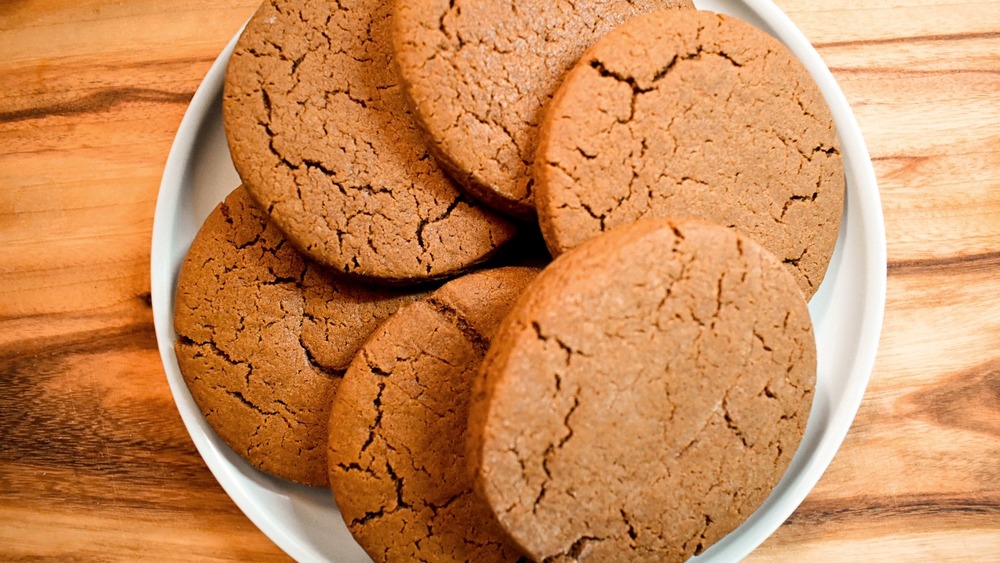
Ingredients
- 1/3 cup butter, softened
- 1/3 cup vegetable shortening
- 1/2 cup packed light brown sugar
- 1 egg, at room temperature
- 3/4 cup molasses
- 2 teaspoons cinnamon
- 2 teaspoons ginger
- 1/4 teaspoon salt
- 1 teaspoon baking soda
- 1/2 teaspoon baking powder
- 3 cups all-purpose flour
Directions
- In the bowl of a stand mixer, or in a large mixing bowl using an electric hand mixer, cream together shortening, butter, and brown sugar. Once the mixture is very light and fluffy, add in the egg, molasses, cinnamon, and ginger. Beat on medium speed until thoroughly combined, then remove the bowl from the mixer and set aside.
- In a medium-sized mixing bowl, sift together baking soda, baking powder, salt, and flour. Sift the dry ingredients a second time directly into the mixing bowl, and use a rubber spatula or wooden spoon to stir the cookie dough until no visible streaks of flour remain. The dough at this point should be soft and sticky.
- Wrap the cookie dough tightly in plastic wrap and chill in the refrigerator for at least two hours and as long as two days. Chilling the dough overnight tends to be best, and allows you to bake cookies first thing in the morning.
- Flour your work surface and turn out the chilled dough. Flour the top of the dough and your rolling pin, and roll out the dough to your desired thickness. For softer, chewier cookies, aim for around a half inch. For thinner, crispier cookies, or for gingerbread houses, between one eighth and one quarter of an inch works best.
- Place cookies at least an inch apart on a parchment-lined baking sheet, and bake at 350 degrees Fahrenheit for around 10 minutes. If you're making especially small cookies, reduce the baking time to around 8 minutes. Cookies are done when the tops are slightly cracked and the edges are fully set.
- Cool completely on a wire rack, then store in an airtight container. Gingerbread cookies will keep for 4-6 weeks if stored properly.
Nutrition
| Calories per Serving | 156 |
| Total Fat | 5.7 g |
| Saturated Fat | 2.4 g |
| Trans Fat | 0.5 g |
| Cholesterol | 13.4 mg |
| Total Carbohydrates | 24.5 g |
| Dietary Fiber | 0.5 g |
| Total Sugars | 12.4 g |
| Sodium | 91.2 mg |
| Protein | 1.9 g |
